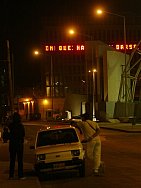Cuban Holiday

I have never been to Cuba, so I decided to take a virtual trip there this weekend. I brought back plenty of Virtualpolitik with me, which I will now unpack from my cyber suitcase.
I started my Caribbean jaunt with the official website of Cuba, where I was immediately informed by a rolling banner: "US Maneuvers to Grant Parole to Terrorist." Unfortunately, the next helpful page had too many broken links to give me my opportunity to "send a letter to the Attorney General." (On a previous trip to North Africa, I found out that the website of Libyan leader Muammar Gadafi had less interactive anti-American vitriol to offer, but it did use the words "so-called" a bit more.)
Then where could be better than Guantanamo Bay, Cuba -- home to an unspecified number of foreign detainees? This Welcome Aboard letter certainly made me feel right at home. Sure, I had to be considerate on my vacation, and not abuse my barbecue privileges, and keep in mind that all important holiday pet safety. Of course, this time of year, I had to check the weather report before I went surfing, teed off at the 9-hole golf course, or took a dip in one of the three GTMO pools. So I'll have to plan a return visit at a sunnier time of year.
Back in Havana, I stopped by the US Interests section, on the site of the former U.S. embassy. In recent weeks, a new giant LED sign on the American Mission proclaims the International Declaration of Human Rights, the words of Martin Luther King, and various other sayings about individual liberty translated into Spanish. During the day the letters are apparently hard to decipher, and the billboards of Iraqi detainees and swastikas dominate the visual landscape. But at night the U.S. Human Rights News 'Zipper' glitters under the Cuban sky, and ups the high-tech ante in the current "US-Cuba Billboard War."
The LED zipper sign format has been used by artists like Jenny Holzer and by Mark Hansen and Ben Rubin of Ear Studio for art installations that explore the nature of public rhetoric. But, given the institutional context, does a sign on a building signal democratic activism or the Spanish subtitles of mere political propaganda? For resistance at street level I prefer the grungy approach of the Italian telestreet movement or the use of mobile phone technology by smart mobs in China. The Havana sign is a little too Wall Street for me.
Labels: human rights, institutional rhetoric

0 Comments:
Post a Comment
<< Home